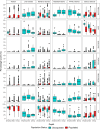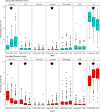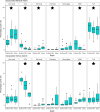Local human impacts interact with geography to drive benthic community depth zonation on contemporary coral reefs
- PMID: 40495816
- PMCID: PMC12152746
- DOI: 10.1098/rspb.2024.1885
Local human impacts interact with geography to drive benthic community depth zonation on contemporary coral reefs
Abstract
Changes in biophysical conditions and energetic resource supply across depths are predicted to promote or limit the abundance of different coral reef benthic groups. However, the degree to which regional differences in biophysical processes govern and local human activities might alter naturally occurring depth zonation patterns remains unclear. Here, we used 2239 reef surveys conducted between 0 and 30 m depth around 33 islands (18 unpopulated and 15 populated) across the Pacific Ocean to quantify the percentage cover change of seven broad benthic groups. We tested whether natural depth zonation patterns differed across geographies (using six ecoregions) and whether and how local human impacts might disrupt these natural zonation patterns. We found benthic community depth zonation did not always occur. At the three ecoregions where depth zonation existed, there was no universal 'natural' zonation pattern and the benthic groups most responsible for driving patterns of depth zonation differed across geographies. We also found evidence of human-disrupted changes to benthic community depth zonation; patterns were inversed across depths and less distinct at populated compared to unpopulated islands within two ecoregions. We show coral reef communities are naturally highly variable and that human activities can disrupt natural patterns of ecological organization in contemporary ecosystems.
Keywords: Pacific Ocean; anthropogenic impacts; benthic assemblages; depth strata; spatial heterogeneity; vertical zonation.
Conflict of interest statement
We declare we have no competing interests.
Figures





Similar articles
-
Coral reef benthic community changes in the Anthropocene: Biogeographic heterogeneity, overlooked configurations, and methodology.Glob Chang Biol. 2022 Mar;28(6):1956-1971. doi: 10.1111/gcb.16034. Epub 2021 Dec 24. Glob Chang Biol. 2022. PMID: 34951504
-
Viral predation pressure on coral reefs.BMC Biol. 2023 Apr 11;21(1):77. doi: 10.1186/s12915-023-01571-9. BMC Biol. 2023. PMID: 37038111 Free PMC article.
-
Atoll-dependent variation in depth zonation of benthic communities on remote reefs.Mar Environ Res. 2022 Jan;173:105520. doi: 10.1016/j.marenvres.2021.105520. Epub 2021 Nov 6. Mar Environ Res. 2022. PMID: 34775207
-
Impacts of typhoons Molave and Goni on benthic macroinvertebrate communities in Apo Reef Natural Park, Philippines.Environ Monit Assess. 2025 Aug 26;197(9):1041. doi: 10.1007/s10661-025-14498-1. Environ Monit Assess. 2025. PMID: 40856853
-
Pharmacological and electronic cigarette interventions for smoking cessation in adults: component network meta-analyses.Cochrane Database Syst Rev. 2023 Sep 12;9(9):CD015226. doi: 10.1002/14651858.CD015226.pub2. Cochrane Database Syst Rev. 2023. PMID: 37696529 Free PMC article.
References
-
- Chase J, Leibold M. 2009. Ecological niches: linking classical and contemporary approaches. Chicago, IL: University of Chicago Press.
-
- Hirzel AH, Le Lay G. 2008. Habitat suitability modelling and niche theory. J. Appl. Ecol. 45, 1372–1381. ( 10.1111/j.1365-2664.2008.01524.x) - DOI
-
- Keddy PA. 1989. Effects of competition from shrubs on herbaceous wetland plants: a 4-year field experiment. Can. J. Bot. 67, 708–716. ( 10.1139/b89-094) - DOI
MeSH terms
LinkOut - more resources
Full Text Sources

